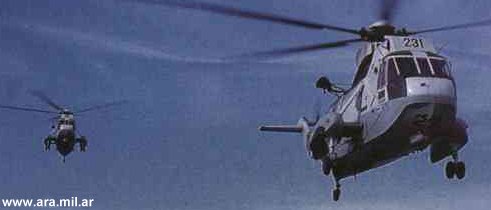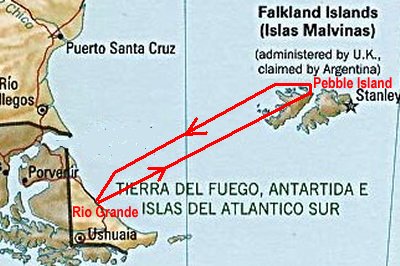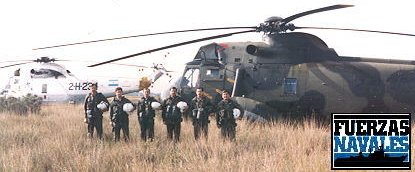In late May 1982 during the Falklands/Malvinas War, the Argentine Naval Command decided
to evacuate the pilots deployed to Estacion Aeronaval Calderon (Naval Air Station) -Pebble Islands-,
since the station was not operative from May 15th, due to a British SAS attack. In order to
accomplish this hair-rising mission, the 2nd Naval Helicopter Sqn (EAH2)
was chosen.
This unit was at the time deployed near Viedma (Argentina), carrying out ASW (anti submarine warfare) tasks. The squadron's flight line was made up by Sikorsky S-61D.4 "Sea King" helicopters (the export variant of USN's SH-3D's), dubbbed locally "SH-3". This helicopters were far from ideal for the rescue mission; their only strong point was their endurance. But they had no electronic countermeasures (ECM), no reliable navigation system (their inertial systems were not very trustable in the opinion of pilots and crew), had no A-A weapons. To top this, their maximum speed was barely in the 135 Knots range.


Nevertheless, at 1835L they took off, aiming for Rio Grande NAS. The flight leader even had to gain altitude, since his NVG's were not working properly, while his wingmen was able to continue flying low. Those were not the only difficulties, since both helos were flying some 600 pounds above their design weight, the JP-1 taken at Calderon was contaminated, and there also was the omnipresent danger of frost.
In any event, the two helos were slowly approaching Rio Grande NAS, and around 2200L they landed. They had managed to pull out a seven hour, over-water and between mountains, flight. A truly remarkable feat for two unarmed, ASW helos, operating under the missile umbrella of the Royal Navy.

Argentine Navy Sea King Crews
Sea King 2-H-233
Lt. Cdr. Norberto Barro (CO, EAH2)
Lt. Guillermo Iglesias
SCPO Beltran Giqueaux
Sea King 2-H-234
Lt. Osvaldo Iglesias
Lt. j.g. Oscar Brandenburgo
CPO Roberto Montani
This unit was at the time deployed near Viedma (Argentina), carrying out ASW (anti submarine warfare) tasks. The squadron's flight line was made up by Sikorsky S-61D.4 "Sea King" helicopters (the export variant of USN's SH-3D's), dubbbed locally "SH-3". This helicopters were far from ideal for the rescue mission; their only strong point was their endurance. But they had no electronic countermeasures (ECM), no reliable navigation system (their inertial systems were not very trustable in the opinion of pilots and crew), had no A-A weapons. To top this, their maximum speed was barely in the 135 Knots range.
In spite of all, these were the only aircraft available for the rescue
mission. In order to give them more endurance, all ASW equipment was
removed, using up the available space and weight to install fuel bladders,
which would transfer JP-1 to the main tanks due to a manually-operated pump.
Other field improvements were the addition of a VLF-Omega NAV system, as well as NVG's (night vision goggles) for the pilots. Of course, the SH-3's had, at that time, no NVG-compatible instruments, so they were to be used cautiously.
Other field improvements were the addition of a VLF-Omega NAV system, as well as NVG's (night vision goggles) for the pilots. Of course, the SH-3's had, at that time, no NVG-compatible instruments, so they were to be used cautiously.

On May 31st, 1982, two SH-3 helicopters (serials 2-H-234 and 2-H-233)
arrived to Rio Grande NAS (Naval Air Station). At the base, one of the helos was given a
field-expedient cammo scheme, while the urgency of the rescue prevented the
other aircraft from being repainted. The NVG's were tried too, without much
success. On June 1st, 1400L they took off for NAS Calderon. In the first
120 NM of the trip, they had a Coast Guard SA 330 Puma
as NAV support.
Arround 1725L they landed at NAS Calderon, in the midst of worsening meterological conditions that, however, gave them some measure of visual cover against the British Task Force combat air patrols of Sea Harriers and anti aircraft missiles of their ships.
Once safely landed, the crews soon start to refuel the helos. However, the hitherto trustable VLF-Omega started to go dead.
Arround 1725L they landed at NAS Calderon, in the midst of worsening meterological conditions that, however, gave them some measure of visual cover against the British Task Force combat air patrols of Sea Harriers and anti aircraft missiles of their ships.
Once safely landed, the crews soon start to refuel the helos. However, the hitherto trustable VLF-Omega started to go dead.

Nevertheless, at 1835L they took off, aiming for Rio Grande NAS. The flight leader even had to gain altitude, since his NVG's were not working properly, while his wingmen was able to continue flying low. Those were not the only difficulties, since both helos were flying some 600 pounds above their design weight, the JP-1 taken at Calderon was contaminated, and there also was the omnipresent danger of frost.
In any event, the two helos were slowly approaching Rio Grande NAS, and around 2200L they landed. They had managed to pull out a seven hour, over-water and between mountains, flight. A truly remarkable feat for two unarmed, ASW helos, operating under the missile umbrella of the Royal Navy.

Argentine Navy Sea King Crews
Lt. Guillermo Iglesias
SCPO Beltran Giqueaux
Lt. j.g. Oscar Brandenburgo
CPO Roberto Montani
